“Global In-store Analytics Market to reach a market value of USD 22.34 Billion by 2032 growing at a CAGR of 21.4%”
The Global In-store Analytics Market size is expected to reach $22.34 billion by 2032, rising at a market growth of 21.4% CAGR during the forecast period.
The North America segment recorded 37% revenue share in the market in 2024. This growth can be attributed to the high adoption of advanced retail technologies across the region, particularly in countries like the United States and Canada. Retailers in North America have increasingly embraced data-driven strategies to enhance customer experience, optimize inventory management, and boost operational efficiency. The presence of key market players and the availability of robust infrastructure for data collection and analytics have further contributed to the region’s leadership in the market.
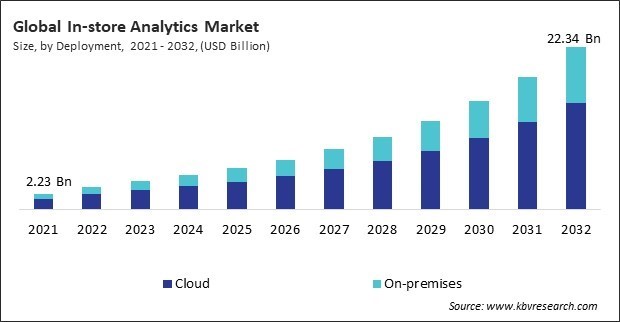
The major strategies followed by the market participants are Product Launches as the key developmental strategy to keep pace with the changing demands of end users. For instance, In March, 2025, SAP SE unveiled AI-driven retail solutions, including SAP S/4HANA Cloud Public Edition and a generative AI assistant, Joule. These tools aim to enhance customer engagement, streamline operations, and optimize supply chains. Retailers are adopting AI for personalized experiences, efficient inventory management, and dynamic pricing strategies. Moreover, In January, 2025, Zebra Technologies Corporation unveiled new AI-powered solutions designed to enhance retail frontline operations. These innovations focus on improving customer service, streamlining workflows, and optimizing store management with real-time insights. By leveraging advanced technology, Zebra aims to empower retail teams, ensuring better decision-making and efficient operations for both in-store and online environments.
Based on the Analysis presented in the KBV Cardinal matrix; Microsoft Corporation is the forerunner in the In-store Analytics Market. In January, 2024, Microsoft Corporation unveiled new generative AI data tools tailored for the retail sector. These innovations aim to help retailers enhance decision-making, optimize operations, and improve customer experiences by leveraging AI-powered analytics and data insights. The tools are part of Microsoft’s ongoing push to advance industry-specific AI solutions. Companies such as IBM Corporation, Honeywell International, Inc., and SAP SE are some of the key innovators in In-store Analytics Market.
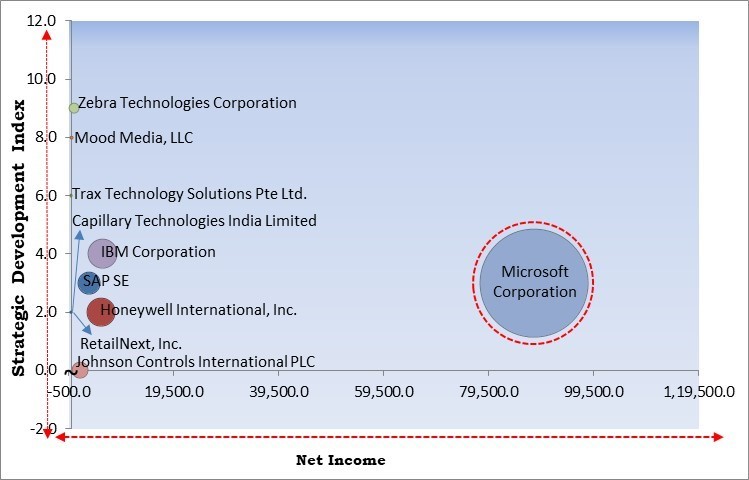
The retail landscape transforms as businesses increasingly leverage advanced technologies to deliver superior customer experiences and optimize operations. These analytics solutions play a central role in this transformation, enabling retailers to gather and analyze vast amounts of real-time data on customer behaviors, store performance, product engagement, and sales trends. By utilizing computer vision, IoT sensors, and Wi-Fi tracking, retailers can better understand how customers interact with physical spaces. Thus, the growing integration of advanced technologies in retail is transforming customer experiences and streamlining operations, setting a strong foundation for the widespread adoption of in-store analytics.
Additionally, The growing emphasis on data-driven decision-making in retail fuels the demand for these analytics solutions. With the increasing complexity of consumer behavior and heightened competition, retailers can no longer rely on intuition or outdated sales reports to guide strategy. These analytics empowers retailers with granular, actionable insights into every aspect of the customer journey—from entrance to exit—allowing them to make informed decisions based on actual behavior patterns. As a result, businesses that prioritize data-driven insights are better positioned to navigate market fluctuations, improve ROI, and enhance their overall competitiveness in a rapidly evolving industry.
However, One of the major barriers hindering the widespread adoption of these analytics is the substantial initial investment required for implementation. Retailers, particularly small and mid-sized enterprises, often find the capital expense associated with hardware, software, integration, and infrastructure upgrades daunting. Solutions such as AI-enabled cameras, sensors, advanced POS systems, cloud storage, and analytics dashboards require a significant financial outlay. As a result, despite the transformative potential of these analytics, high costs remain a critical roadblock to market penetration, especially among smaller players.
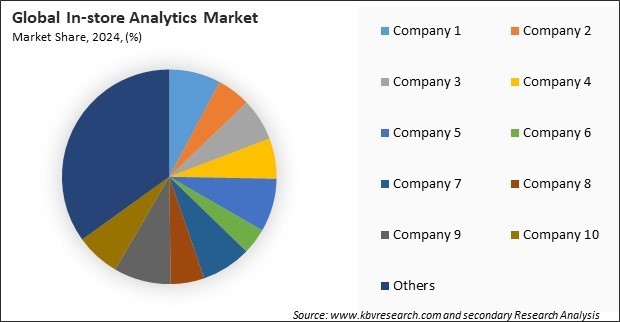
The leading players in the market are competing with diverse innovative offerings to remain competitive in the market. The above illustration shows the percentage of revenue shared by some of the leading companies in the market. The leading players of the market are adopting various strategies in order to cater demand coming from the different industries. The key developmental strategies in the market are Product Launches and Product Expansions.
Free Valuable Insights: Global In-store Analytics Market size to reach USD 22.34 Billion by 2032
On the basis of deployment, the market is classified into cloud and on-premises. The on-premises segment recorded 32% revenue share in the market in 2024. This deployment model remains preferred for large retailers and enterprises that prioritize data security, control, and compliance with industry-specific regulations. On-premises solutions allow businesses to maintain direct oversight of their data infrastructure and customize analytics systems according to specific operational needs.
Based on Solution Type, the market is characterized into shopper traffic analysis, Inventory management, queue management, planogram compliance, and in-store navigation. The Inventory management segment procured 25% revenue share in the market in 2024. Accurate inventory tracking is crucial for maintaining product availability, minimizing stockouts, and reducing overstock situations. In-store analytics helps retailers monitor stock levels, forecast demand, and streamline replenishment processes. As customer expectations for product availability and speed of service increase, effective inventory management powered by analytics has become an essential component of modern retail operations, driving strong market demand for this application.
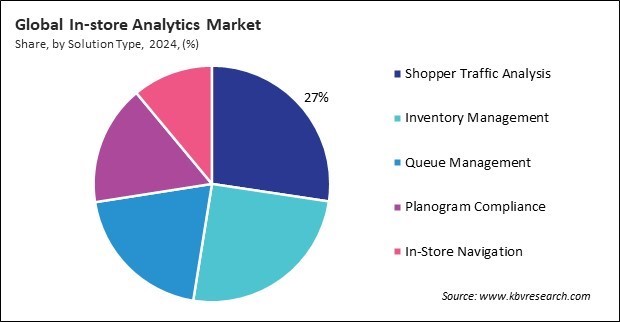
By application, the market is divided into merchandising analysis, retail performance management, customer experience enhancement, and loss prevention & security. The customer experience enhancement segment garnered 28% revenue share in the market in 2024. Retailers have increasingly prioritized personalizing shopping experiences to attract and retain customers. Through in-store analytics, businesses can gain deeper insights into customer preferences, foot traffic patterns, and behavioural trends. This allows for tailored marketing strategies, improved store layouts, and targeted engagement, increasing customer satisfaction.
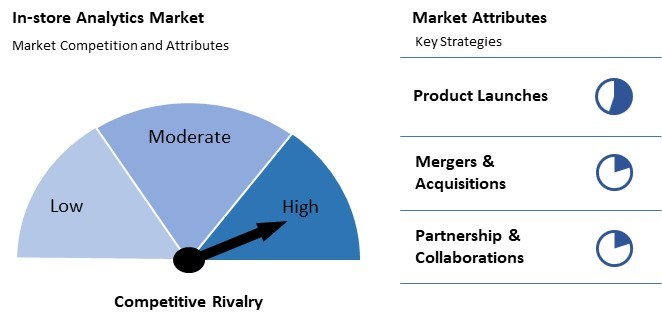
The In-store Analytics Market remains highly competitive, driven by startups and mid-sized firms offering specialized solutions. These players focus on affordable, AI-driven tools, real-time data processing, and personalized customer insights. Innovation and agility help them capture niche segments, while partnerships with retailers and tech providers enhance their presence in this rapidly evolving, data-centric retail environment.
Region-wise, the market is analyzed across North America, Europe, Asia Pacific, and LAMEA. The Europe segment witnessed 30% revenue share in the market in 2024. This was primarily driven by the increasing digital transformation in the retail sector across countries such as Germany, the UK, and France. European retailers have invested in in-store technologies to gain actionable insights into customer behaviour and improve overall store performance. The growing emphasis on improving customer engagement and regulatory support for digital innovation has facilitated the deployment of advanced analytics tools.
| Report Attribute | Details |
|---|---|
| Market size value in 2024 | USD 4.80 Billion |
| Market size forecast in 2032 | USD 22.34 Billion |
| Base Year | 2024 |
| Historical Period | 2021 to 2023 |
| Forecast Period | 2025 to 2032 |
| Revenue Growth Rate | CAGR of 21.4% from 2025 to 2032 |
| Number of Pages | 274 |
| Number of Tables | 373 |
| Report coverage | Market Trends, Revenue Estimation and Forecast, Segmentation Analysis, Regional and Country Breakdown, Competitive Landscape, Market Share Analysis, Porter’s 5 Forces Analysis, Company Profiling, Companies Strategic Developments, SWOT Analysis, Winning Imperatives |
| Segments covered | Deployment, Solution Type, Application, Region |
| Country scope |
|
| Companies Included | RetailNext, Inc., Capillary Technologies India Limited, SAP SE, Honeywell International, Inc., Microsoft Corporation, Mood Media, LLC , IBM Corporation, Johnson Controls International PLC, Trax Technology Solutions Pte Ltd., and Zebra Technologies Corporation |
By Deployment
By Solution Type
By Application
By Geography
Our team of dedicated experts can provide you with attractive expansion opportunities for your business.
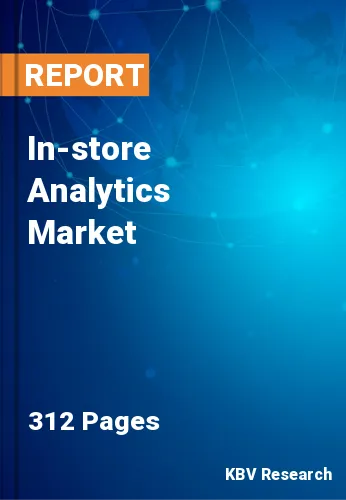
 Drivers
Drivers
 Restraints
Restraints
 Opportunities
Opportunities
 Challenges
Challenges
